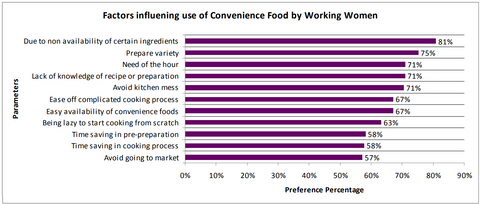Introduction:
Over the past decade and a half, India has witnessed a remarkable surge in the number of working women, reflecting a shift in societal norms. Simultaneously, the convenience food industry has experienced unprecedented growth. This study delves into the relationship between working women and convenience foods, exploring their preferences, choices, and the benefits they perceive in utilizing such products.
Changing Landscape of Indian Lifestyle:
Traditionally, Indian home-cooked meals, infused with a mother's touch, have been a staple, providing unique flavors and personalization. However, with the evolving dynamics of Indian society, more women are joining the workforce, pursuing careers alongside their domestic responsibilities. This shift has sparked a surge in the demand for convenient solutions in meal preparation.
Convenience Foods: A Growing Trend:
Convenience food, characterized by its ease of consumption, has become a lifeline for the modern Indian working woman. From frozen and pre-processed items to ready-to-eat snacks and canned products, the convenience food industry is adapting to the diverse needs and preferences of consumers. This growth is particularly evident among the youth and the younger generations, marking a significant shift in dietary habits.
Objectives of the Study:
- Identify the factors influencing the use of convenience foods by working women.
- Explore the various categories of convenience foods available for working women.
- Examine the preferences of working women concerning different categories of convenience foods.
- Uncover the perceived benefits of convenience foods for working women.
Categories of Convenience Foods:
-
Storage Food and Long Shelf Life:
- Frozen delights, canned treasures, and bottled marvels.
-
Prepared Meals and Ready-to-Eat Options:
- Ready-to-serve goodness, fresh-cut vegetables, and pre-processed wonders.
-
Convenience in Emergency:
- Non-perishable items that serve as emergency food.
Research Methodology:
The study combines primary and secondary data, with personal interviews and questionnaires administered to over 100 working women. Secondary data is collected through a comprehensive literature review of research papers, articles, and books. The findings are presented graphically to facilitate a clearer understanding.
Factors Influencing Convenience Food Usage:
The research reveals several factors driving the adoption of convenience foods by working women. These include avoiding trips to the market, time-saving in cooking and pre-preparation, ease of availability, and a desire for variety in meals. Additionally, factors like lack of recipe knowledge, the need for quick meal solutions, and preparation for emergency situations contribute to the popularity of convenience foods.

Preference for Convenience Food Categories:
The study outlines the categories of convenience foods favored by working women. While preferences may vary, bottled products and ready-to-eat snacks emerge as popular choices. The convenience of frozen snack and non-vegetarian products is less pronounced, indicating a diverse range of preferences among working women.

Benefits of Convenience Foods:
Working women cite several benefits associated with the use of convenience foods, including time savings, variety in meal preparation, ease of cooking, and suitability for emergency situations. Notably, the ability to prepare off-seasonal foods emerges as a significant advantage, catering to the changing needs and expectations of working women.

The study suggests that working women should prioritize understanding the health benefits and storage conditions of specific convenience products. It also calls for ongoing research to capture evolving perceptions and expectations based on demographic factors.
In conclusion, the synergy between working women and convenience foods reflects a dynamic shift in Indian lifestyles. Convenience foods are not merely products; they embody a solution to the evolving challenges faced by modern, career-oriented women, providing them with the flexibility and ease they need in managing their diverse roles. As the convenience food industry continues to adapt and innovate, its role in empowering working women is poised to become even more integral.


